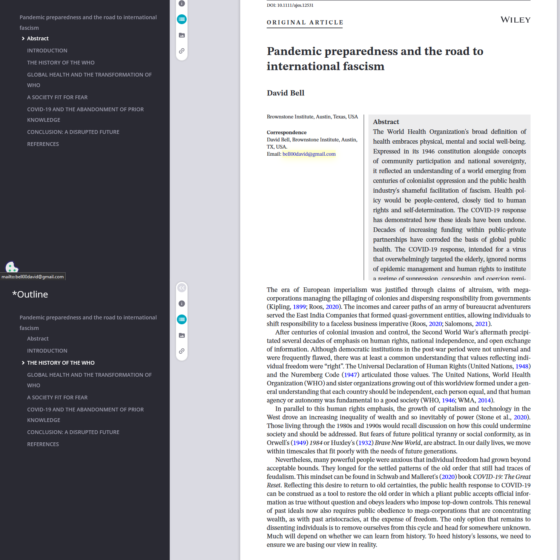Key scientists advising the World Health Organization on planning for an influenza pandemic had done paid work for pharmaceutical firms that stood to gain from the guidance they were preparing. These conflicts of interest have never been publicly disclosed by WHO, and WHO has dismissed inquiries into its handling of the A/H1N1 pandemic as “conspiracy theories.” Deborah Cohen and Philip Carter investigate
Cohen D, Carter P. Conflicts of interest: WHO and the pandemic flu “conspiracies”. BMJ 2010;340:c2912. doi:10.1136/bmj.c2912 PMID:20525679
Fulltext: true-democracy.ch/wp-content/uploads/WHO-Swine-Flu-Conspiracies-British-Medical-Journal-2010.pdf
There has been considerable controversy over the past year, particularly in Europe, over whether the World Health Organization (WHO) changed its definition of pandemic influenza in 2009, after novel H1N1 influenza was identified. Some have argued that not only was the definition changed, but that it was done to pave the way for declaring a pandemic. Others claim that the definition was never changed and that this allegation is completely unfounded. Such polarized views have hampered our ability to draw important conclusions. This impasse, combined with concerns over potential conflicts of interest and doubts about the proportionality of the response to the H1N1 influenza outbreak, has undermined the public trust in health officials and our collective capacity to effectively respond to future disease threats.
WHO did not change its definition of pandemic influenza for the simple reason that it has never formally defined pandemic influenza. While WHO has put forth many descriptions of pandemic influenza, it has never established a formal definition and the criteria for declaring a pandemic caused by the H1N1 virus derived from “pandemic phase” definitions, not from a definition of “pandemic influenza”. The fact that despite ten years of pandemic preparedness activities no formal definition of pandemic influenza has been formulated reveals important underlying assumptions about the nature of this infectious disease. In particular, the limitations of “virus-centric” approaches merit further attention and should inform ongoing efforts to “learn lessons” that will guide the response to future outbreaks of novel infectious diseases.
Central to this debate has been the question of whether H1N1 influenza should have been labelled a “pandemic” at all. The Council of Europe voiced serious concerns that the declara-tion of a pandemic became possible only after WHO changed its definition of pandemic influenza. It also expressed misgivings over WHO’s decision to withhold publication of the names of its H1N1 advisory Emergency Committee.3 WHO, however, denied having changed any definitions and defended the scien-tific validity of its decisions, citing “numerous safeguards” for handling potential conflicts of interest.5






